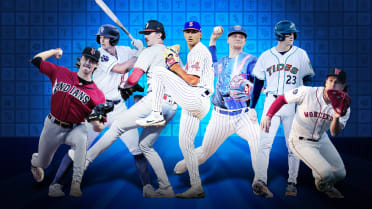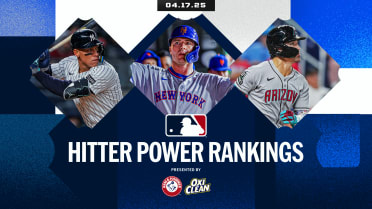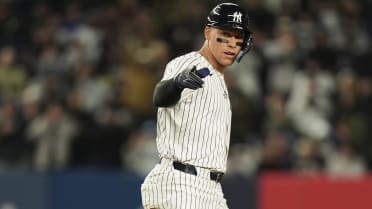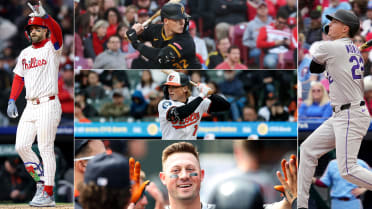When we detailed how fantastic Orioles rookie Adley Rutschman was at blocking pitches in 2022, we promised we’d follow up with a little more about the new metric that says he’s great and share some other stories that we can tell with it. So let’s do exactly that.
1) What are we trying to measure, and how much does it matter?
We’re trying to give credit to catchers for doing a good (or poor) job of achieving what the name of the position implies: catching.
The way this works, as detailed further by MLB.com’s Tom Tango here, is based largely on the location of the pitch (including whether it bounced or not) and the location of the catcher (actual, not assumed), and then further accounts for the speed and movement of the pitch and the handedness of the batter and pitcher.
Of course, not every pitch is created equally. Clearly, there’s no block chances when a batter makes contact, or when he’s hit by the pitch. An off-target pitch not collected by the catcher doesn’t matter so much when there’s no runner on base to advance. You take all those out, and all of a sudden the more than 700,000 pitches in the Majors last season turn into just under 200,000 blockable opportunities, or about 28%. So, for each pitch where a block is important to make, that chance is given a block probability, based on all the inputs we shared above.
For example, this nice stop on a wild slider by Kevin Plawecki is an opportunity a catcher handles just 37% of the time. But this one that Joey Bart fails to corral, even though it’s marked as a “wild pitch,” not a “passed ball,” is one that should be stopped 95% of the time.
What that means, then, is that every opportunity is hardly created the same, and the most difficult ones are relatively few and far between – as you might expect given that nearly 70% of pitches last year were either in the strike zone or on the edges, and the total of 2,418 passed balls or wild pitches comes out to roughly one per game, or one per every 292 pitches.
If we split all of those 200,000 or so blocking chances per year into “easy,” which are the ones with a 95% likelihood of being blocked; “medium,” those between 85%-95%; and “tough,” those chances under 85%, you’ll find more or less what you expect. More than 95% of chances are rated as easy, because they’re almost always caught.
Which leads into the question that’s always a thorny issue: How much does it matter? The answer is: it does, but less than you want it to. You can see a missed pitch -- one that’s not caught or goes to the backstop -- a whole lot easier than you can see a well-framed pitch. Yet because there’s many, many more borderline frameable pitches per game than borderline block chances, the spread is much smaller.
If we convert blocks and framing chances into runs, to put them on the same scale, the spread between the best and worst blockers is approximately 10 runs, or one win, in WAR terms. The spread between best and worst framers is more on the scale of 30 to 40 runs, or three to four wins.
So yes, it matters. It just doesn’t matter as much as framing does.
2) We can see which catchers were really good in 2022
Let’s bring back the “Adley is great” leaderboard to show you who else did well this past season.
All expected names, right? Jose Trevino did win the American League Platinum Glove award this past year, after all, and this isn’t exactly new for him. In addition to rating as 2022’s best framer, he’d also rated quite well in blocking (+8 blocks, 11th-best) as a Ranger in 2021, and had won Minor League Gold Gloves in the Texas system in 2016 and ‘17. (It’s fascinating to watch his pre-game blocking practice.)
By the numbers, one of Trevino's most difficult stops of the season came on Aug. 12 in Boston. We’re not incorporating game context into this stat, though that doesn’t mean you can’t; as Yankees broadcaster Michael Kay notes, here, given that it’s a 1-1 tie in the bottom of the ninth with a runner on third base, “Trevino just saved the game.”
Unsurprisingly, it’s been a pretty massive improvement for the Yankees going from Gary Sanchez (-22 blocks in 2020-’21, second-weakest) to Trevino. Which was exactly the point.
New Brave Sean Murphy was a 2021 Gold Glover (“you look at all the tools — the throwing, the blocking, the hands — all of that is plus,” GM Alex Anthopoulos said after trading for him) and J.T. Realmuto’s reputation precedes him. Wondering why Tomás Nido (+12 blocks and +5 framing runs) is still in New York and James McCann (-6 blocks and +2 framing runs) is not? It’s not just about the bat.
At the opposite end, Royals rookie MJ Melendez (-25 blocks above average) rated nearly twice as weak as the next-weakest catcher (Yasmani Grandal, who had knee injuries each of the past two seasons). The Royals aren’t unaware; while Melendez may still see time as a backup to Salvador Perez, he’s also likely to be Kansas City’s starting left fielder.
3) Can we look at two identical pitches with two different outcomes?
Sure. We can take all of the inputs about movement and location and find two pitches that looked about the same.
To that end, here are two extremely similar opportunities presented to two different catchers. On the left of the following video, a lefty pitcher (Nick Lodolo) throws an 82 mph breaking ball that almost hits a righty batter in the back foot. On the right side, you’ll see a lefty pitcher (Andrew Miller) throwing an 80 mph breaking ball that almost hits a righty batter in the back foot.
Austin Romine, Lodolo's catcher, was given a mere 20% expectation to block this one, given the difficulty; that he did so makes it a fantastic play. Matt Wieters, Miller's catcher, had a similarly difficult 15% expectation. That he didn't do so is less a reflection on him and more an understanding of how hard this chance was -- and a credit to Romine.
4) We can easily search for the really great blocks ...
Let's get to the fun ones. What, if we go back over the last three seasons, are the most difficult blocks that catchers have made, according to the numbers? There's a small -- very small -- handful of stops that came on chances that turned into mistakes north of 90% of the time. Our favorite one, visually, came from Angels rookie Logan O'Hoppe, who got into just five Major League games at the end of '22.
Another fun one came from Murphy, then still with the A's, who had his vision blocked by 6 feet and 7 inches worth of Aaron Judge.
4) ... and the worst misses
Sorry about this. We showed some great plays, and now it's time for the other side. Going to the opposite end will show what the metric sees at the bottom, and it’ll help you to see what’s good when you see what’s … not.
There’s a bit of a tie on the bottom end here, so to break it down, let’s pick a fastball, closest to the middle of the zone, without a swing in front of it. The honor, such as it is, goes to: Mike Zunino. Which is, at least in part, how you get to the third-from-last spot on our three-season list.
That’s unfortunate.
Sometimes, though, there’s only so much a catcher can do. This Realmuto whiff – also, interestingly, from José Alvarado – looks bad, right? Yet Realmuto is considered excellent at this.
Turns out, that was a miscommunication, with Realmuto expecting a slider, and instead receiving a 99.4 mph sinker. Catching isn’t easy. Ever.
6) We can tell when an entire catching contingent is weak. Enter, the Giants without Buster Posey.
This is not exactly game-changing news, since Posey might be a future Hall of Famer. But since he’s played in exactly one of the past three seasons – choosing not to participate in 2020, then retiring after a very successful 2021 – you can really see the impact, and as you can imagine, his presence was enormous. At the plate in the past three years, Giants catchers were 27th (2020), 3rd (2021, with Posey), and 12th (2022). In framing, it was 11th (2020), 5th (2021, with Posey), and 22nd (2022).
Maybe you’d think this extended to receiving the ball, too. You’d be right. They were tied-17th in 2020, 4th-best in 2021 (with Posey), and tied-16th in 2022. But since Curt Casali came in at -5 that year, that somewhat undersells what Posey really did. Maybe this look at all Giants catchers over those three seasons will show it a little better.
It’s a tremendous difference; Posey’s 2021 is actually the third-best season we have among our three seasons here.
The best part, then, is when we went looking for the block of his that graded out as being the most difficult that year. Does it look great? It sure does. But more important than that – and not given extra credit in the metric – it came in the playoffs. In the eighth inning. Of a 1-1 tie. Against the Dodgers. In a game that would turn out to be the final one of Posey's career.
San Francisco didn't end up winning this game, but they also didn't lose the lead right here, as they could have if not for Posey.
7) We can also tell when a group of backstops is really helping starters. Enter, the Nationals not hurting Patrick Corbin as much as we thought.
Corbin has had a tough go of it since the Nationals won a title in 2019, posting a 5.82 ERA across three increasingly ineffective seasons. There’s no sugar-coating that his decline is tied to his own pitching; look no further than the strikeout rate that was 31% in his final year with Arizona (2018) dropping to a mere 18% with Washington in 2022.
But, too, there was evidence that Washington’s worst-in-baseball defense was hurting him more than any other fielders behind any other team. In 2022, Corbin’s non-catcher fielders were a shocking -20 Outs Above Average behind him – easily the weakest support any pitcher received – and that’s held true over the past three seasons combined.
So imagine our surprise, then, when we looked at which pitchers were benefiting the most from good blocking and found … Patrick Corbin, regularly getting help despite the fact the Nationals have had multiple catchers (Yan Gomes, Keibert Ruiz and Riley Adams) over the past three years.
To be clear, this is not enough to overcome the lack of support he’s getting elsewhere. If we convert everything from outs and blocks and pitches to just runs, to get it on the same scale, then Corbin’s support over the past three years looks like this:
- -19 runs (defense)
- -5 runs (framing)
- +4 runs (blocking)
It’s still not great. But it’s at least slightly less non-supportive.
8) We can tell when upgrades definitely worked. The Marlins were worst, so they got the best.
Take a moment to realize what the Marlins did last year. In 2021, they were the worst blocking team in the sport (-24 blocks), primarily due to Jorge Alfaro. So after the season, Miami traded Alfaro to San Diego and then sent three players to Pittsburgh for 2021 Gold Glove winner Jacob Stallings, who had been 2021’s best blocker.
Stallings took a slight step back in 2022, though he still rated as a strong blocker (+9 blocks, tied for 8th-best). But as a team, the Marlins went from 30th to 8th.
You can see the difference, too. For example, look at this pitch from Anthony Bender in 2021, an 85.4 mph breaking ball to a righty batter that Alfaro doesn’t come close to getting. Now look at a very, very similar chance in 2022 that Stallings does block, saving Dylan Floro in a key extra innings spot.
9) We can tell which pitchers are helping their catchers ... and it must be nice to catch Scott Effross.
In Effross’s Major League debut in August of 2021, he let loose a wild pitch on the first pitch against the second batter he ever faced. He’s since faced 285 batters, through being traded from the Cubs last year to the Yankees, right up to injuring his elbow, and didn’t have a single other miscue, either passed ball or wild pitch. Is that good catching? Sure, maybe. But it’s also because Effross throws everything – everything! – in a way that makes it reasonable for his catchers to receive it.
Over the past three seasons, we have 594 pitchers who have thrown at least 250 pitches that we’re considering to be block opportunities. Any chance that’s blocked at least 95% of the time is called an "easy" one, and 99.4% of Effross’s pitches have been exactly that. It’s the easiest catching of any pitcher. Just look at this. Nothing in the dirt. Very little that's extremely wide to the left or right. The catcher might as well just pull up an easy chair.
On the other side? Spare a thought for Detroit’s Alex Lange, who has thrown the lowest rate of "easy" pitches among active pitchers (86.7%), who has not only made life difficult on his catchers, but has also had to deal with the fact that those catchers have underperformed even those low expectations, by 9 extra missed blocks.
Remember how much of the zone Effross caught above, and shield your eyes from this.
On the other hand, that doesn’t make it easy on hitters, either. While Lange unsurprisingly walked far too many, he also had an elite curveball whiff rate and a 95th-percentile chase rate. Which makes sense, seeing that. You’d have to chase.
Mike Petriello is a stats analyst for MLB.com, focusing on Statcast and Baseball Savant, and is also a contributor to MLB Network.




